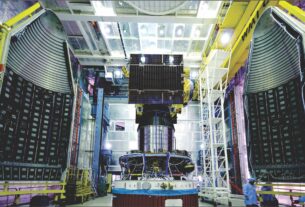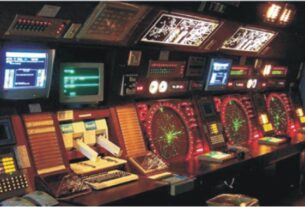Situational awareness based on the real time acquisition of information holds the key to getting a holistic view of the battlefield scenario. Indeed, the efficacy of a network centric warfare strategy is directly related to the information superiority achieved through the optimum use of sensors and radars deployed on a range of platforms.
In recent years, the vastly enhanced surveillance capability of the radars and sensors mounted on aircraft platforms has been playing a critical role in giving a new edge to the defensive and offensive capabilities of the defence forces. Clearly and apparently, air borne surveillance radars have catapulted into the very heart of the C4ISR (Command, Control, Communications, Computer, Intelligence, Surveillance and Reconnaissance) system. An air borne surveillance platform working in tandem with space borne sensors-both passive and active-could give a big push to the battlefield strategy with particular reference to the final outcome of a short lived conflict or war. As such, armed forces across the world are more than keen to deploy a range of sensors and radars on air borne platforms to stay ahead of their adversaries.
At the end of the day, a surveillance system based on an aerial platform can contribute substantially to the enhanced situational awareness and information dominance to stay at the winning edge of the war. An aerial surveillance platform could derive tremendous advantage by operating in tandem with a constellation of satellites designed for functions such as communications, navigation and earth observation.
AWACS platform
By all means, a state of the art AWACS (Airborne Warning and Control System) can complement and enhance the efficacy of a conventional air defence system as it is equipped with capabilities for longer range visibility, larger data collection, big picture analysis and control and command. Further, an AWACS can help detect troops build up, surface naval movement and aerial threats. Clearly and apparently, air borne sensors and space borne sensors are of crucial significance to the defence forces as they provide the necessary lead in tackling emergency situations.
Incidentally, the concept of AWACS became a reality in 1980s consequent to the use of Pulse Doppler radars. As it is, the Indian programme to develop an aerial surveillance system came to an unceremonious end when a lone Avro aircraft serving as the test bed of the system crashed in a flight test in January 1999. This crash killed all the eight people on-board the aircraft. This airborne surveillance platform project spearheaded by the Defence Research and Development Organisation (DRDO) was codenamed Airavat.
In the context of the highly disturbed security environment in India’s immediate vicinity and also taking into account the possibility of India being forced to fight a two front war involving China and Pakistan, India signed a US$1.12 billion deal for the acquisition of three Israel origin AWACS mounted on IL-76 transport aircraft. All the three AWACS were inducted into the IAF formations during 2009-10. This full fledged AWACS system featuring electronically steered phased array radar is designed to make available 360 degree coverage in all directions and of course with the advance warning to help the IAF prepare for counter measure.
The Phalcon radar which happens to be the primary sensor of the system is potent enough to significantly enhance the effectiveness of both defensive and offensive operations. In the ultimate analysis, this air borne, advanced surveillance system is well equipped to monitor huge swathes of Indian air space, intercept communications, log radar frequencies and add some ground surveillance and help command IAF response. By all means, the need for AWACS capability could be felt acutely during conflict situations with China and Pakistan, both of which are in possession of ballistic and cruise missiles of varying categories.
There is no denying the point that the satellite capabilities built up by the Indian Space Research Organisation (ISRO) could be effectively harnessed to boost the capability of this Israel origin “eye in the sky”. In fact, not long back, former IAF chief NAK Browne had highlighted the need for five high end AWACS and ten medium AEW&C (Airborne Early Warning and Control) systems. On their part, Indian strategic experts are of view that India should have sufficient number of AWACS to take care of its security needs in the years ahead. For IAF, the AWACS could serve as a veritable “force multiplier” by making available advance information on the take off of enemy fighters and in the process giving enough time for IAF to scramble its own fighters to counteract them. Another major concern for the Indian defence set up is that Pakistan is already in possession of four Swedish Saab 2000 AEW&C. In addition, Pakistan Air Force (PAF) has started inducting China built advanced Karakoram Eagle AWACS.
In order to supplement the capabilities of three Israeli AWACS and also acquire hands on experience in mastering the state of art technologies involved in building advanced aerial surveillance systems, DRDO took up a project to develop an airborne radar surveillance system that would be mounted on three modified ERJ 145 jets acquired from Brazil. Bangalore based Centre for Airborne Systems (CABS) which functions under DRDO is the lead agency for the development of the Indian AEW&C. While CABS spearheads the design system, integration and testing, Bangalore based DRDO laboratory LRDE (Electronics Research and Development Establishment) is responsible for the design of the radar array of an AEW&C. On the other hand, Defence Electronics Application Laboratory (DEAL) based in Dehradun is responsible for the data link and communications systems of AEW&C.
Interestingly, EMB-145 jet of the Brazilian aircraft major Embraer was chosen as a platform for AEW&C because Brazil, Mexico and Greece based their AEW&C systems on this aircraft. The choice of EMB-145 platform for Indian AEW&C was finalized after ensuring that the aircraft with a MTOW (maximum take off weight) of 24 tonne would optimally meet the needs of AEW&C system including the ability to operate from most of the military airfields in the country.
The home grown AESA radar which is the primary sensor on-board AEW&C has a range of 350 km and is capable of tracking more than 500 targets simultaneously. Sources in CABS point out that AEW&C is capable of sensing the threat scenario, providing early warning and enabling execution of counter measures and counter threats. The focus of the vital mode of operation of the primary radar is on surface surveillance and air surveillance. This sensor has the built in capability to search, track while scan priority tracking.
The long range solid state active phased array radar designed and developed by LRDE stands out as a technology feeder to AEW&C. The secondary surveillance radar (SSR) of AEW&C is designed to identify the target as a friend or foe (IFF). The system as a whole has the capability to sense war like situations in the air to air, air to surface, all weather and day and night modes.
Establishing coordination
Information gathered from a range of satellites along with AEW&C data can help coordinate the strategic moves of the defence forces spread on the land as well as oceanic and air borne platforms. Working in tandem with navigation satellites, communications satellites as well as earth observation satellites, AEW&C could make for a win-win situation on the battlefield front. What is more, interoperability between AWACS and AEW&C platforms and strategically located ground exploitation stations through voice and data channels could be a game changer for the defence forces. Incidentally, the potentials of both AWACS and AEW&C could be synergistically harnessed through linking them with space based assets. Both the systems can access INSAT spacecraft meant for communications, IRS constellation of earth observation satellites and IRNSS navigation space platforms, all of which are being operated by the ISRO.
The Indian AEW&C system with its multiple communications and data links can alert and detect the fighters against threats while providing “recognizable air surveillance picture “to commanders at the Ground Exploitation Stations. The AEW&C system can thus support air force in offensive strike missions and assist forces in the tactical battlefield areas. The communications system of AEW&C is made up of C band data link and Ku band satellite communications link. The C band data link and Ku band sitcom link function as dual redundant system. The Mission Communications System (MCS) of AEW&C is composed of a set of five VHF/UHF sets for air to air voice and data communications.
DRDO describes this multi sensor system with a wide ranging capabilities as a compact, state of the art airborne surveillance system, that marks a significant contribution to the defence preparedness of the country. According to DRDO “The AEW&C India has managed to pack in several systems, namely a highly versatile active array radar system, identification friend or foe system, ELINT(Electronic Intelligence),COMINT(Communications Intelligence) system along with multiple combination of C band data link and Ku band satcom link for voice and data, UHF/VHF/HF communications System and Self Protection System-in order to enhance mission capabilities, add redundancies to fool proof operations and implant self protection against missile attacks from the ground as compared with contemporaries on same Embraer aircraft elsewhere in the world”.
As pointed out by Dr S Christopher, the current head of DRDO who as the chief of CABS had provided the lead to the development of AEW&C, “In today’s warfare, air-borne early warning and control aircraft are equipped to detect, identify and classify hostile intruders and then acting as a command and control centre helping air defence forces neutralize enemy threat”. Giving details, Christopher explains “While India has caught up with the rest of the world in adopting AESA antenna for its radar, the two building block components of the radar, the Transmit-Receive Multi Module(TRMM)and the Teflon clad ultra light antenna panels are notable Indian innovations in the radar subsystem. These are developed by CABS and with a joint patent along with Astra Microwave, Hyderabad for TRMM. The most important outcome of the effort is the realization of a system that is both operationally efficient and cost effective”.
While the first of the AEW&C jet will be inducted into IAF by September this year, the second jet is expected to enter service by the end of this year. And the third AEW&C jet will join IAF sometime next year. DRDO is looking at the possibility of exporting AEW&C to the countries in the South East Asia and Latin American regions. In this context, Christopher says “Currently though the system is customised for IAF, the AEW&C India can be fine-tuned to any specific user oriented early warning product through appropriate programming/software which can be defined by the users. Many countries are evincing keen interest in the AEW&C system and discussions are in progress for the export of this system”.
Based on the success of AEW&C project the AWACS India programme to develop a full fledged aerial warning and control system has been unveiled with a wide body aircraft serving as the platform. It has already been sanctioned by the Indian Government. The AWACS India will feature a state of the art digital radar using innovative technologies and vastly improved TR modules that will provide enhanced ranges and larger capabilities. For this AWACS it is planned to incorporate a rotating radar dome as the primary sensor to realize a 360 degree coverage.
In all it is planned to develop six AWACS with Airbus A330 aircraft serving as the test bed and platform. The Defence Acquisition Council (DAC)has approved the proposal to initially buy two Airbus A330 from Airbus Defence and Space at an estimated cost of Rs 51,130-million with four more to be acquired at a later date. Airbus Defence and Space will be required to integrate the mission system on the aircraft and ensure the safety of the aircraft that would fly with the radar. Incidentally Airbus Defence and Space is involved in jointly reviewing the AEW&C system.





